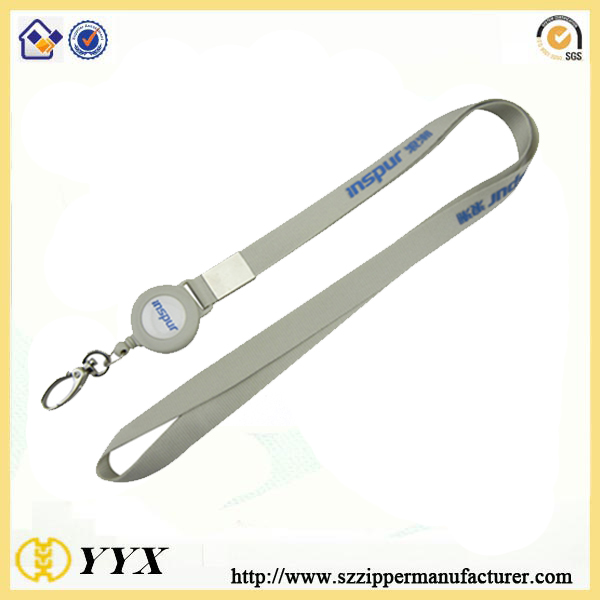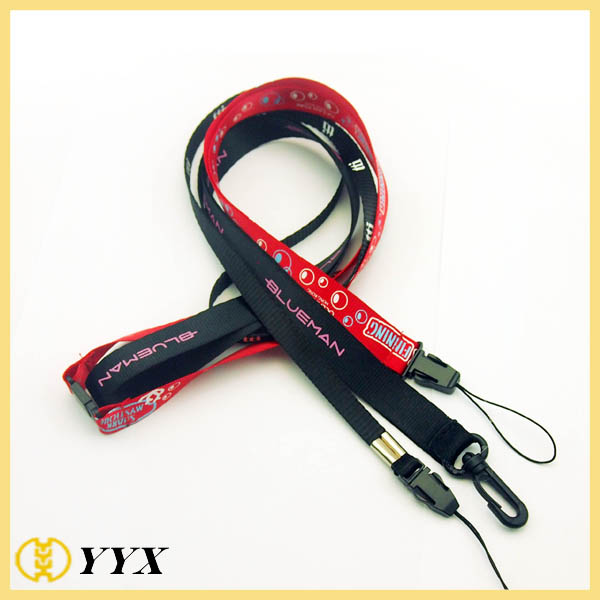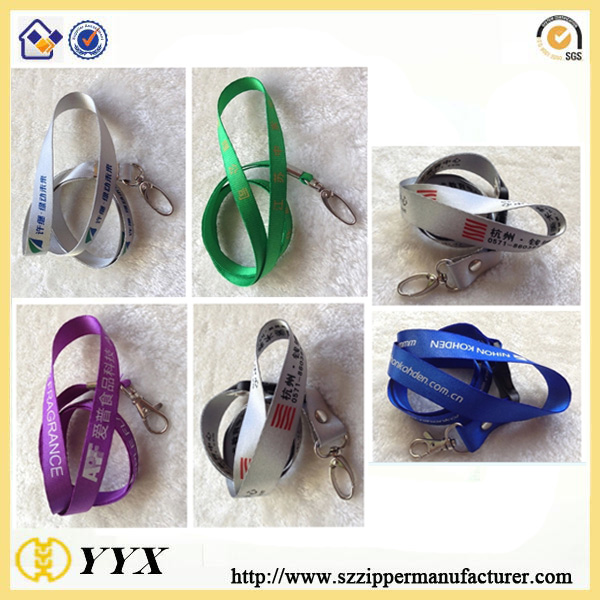Film coating, that is, film, is to apply plastic film adhesive, and paper prints after heating, pressure, make it glue together to form a paper and plastic products a processing technology. The laminated film prints have a thin and transparent plastic film on the surface, and the surface is smoother and brighter. This improves the glossiness and fastness of the printed materials. The graphic and text colors are more vivid and full of three-dimensional, and they are also waterproof. Antifouling, wear-resisting, folding-resistance, chemical resistance, etc. Film Classification Introduction 2. Pre-coated film 3. Waterborne film 4. Curved surface film
What is heat transfer Lanyard?
Heat transfer lanyard is sublimation lanyard is designed in the pattern, production copperplate, electric carving through the mechanical sub-color pattern engraved on copperplate. Copperplate printing machine and then get on the pattern printed on the PET film, and then through the mechanical heat transfer lanyard pattern is transferred to the product. You can see lanyards in use everywhere by businesses, schools, hospitals, at special events, conventions, reunions, and in many recreational activities.
Lanyard:
1. Material: Polyester,Nylon, cotton, PVC, bamboo fiber, tubular, reflective are also available.
2. Size: any size you want; regular sizes: width: 10mm, 15mm, 20mm, 25mm; Length: 900mm
3. Logo imprinting: Sublimation imprinting, Silk-Screen imprinting, Woven logo also can be offered.
4. Attachments: hook and buckles as shown in the below photos.
5. Color:any pattern or pantone color is OK
These are simple decorative device worn and used to protect your small belongings such as keys, ID cards, pens, pocket knife, flash and pen drives, whistles and electronic devices of various magnitude and size in order to prevent them loosing from yourself. Lanyards(Such as custom logo lanyard,heat transfer printing lanyard.) are used in situations where there is a good possibility of losing the object that you carry and use every day. These can be made to various size and length to serve various needs. Whether you are a corporate executive walking around with some sensitive information locked in your flash drive or a maintenance personnel carrying bunch of keys to the various doors of a building that you maintain, these lanyards become a handy tool for you to stay organized.
Lanyards are made from the best quality-assured and durable polyester. Polyester can get your lanyards a soft touch that gives you a quality product with a professionally finished look. Single or multiple color imprinting is possible for your lanyards. Images and texts on Imprinted Lanyards are guaranteed that it will not be damaged if washed or rubbed. We have multiple widths for polyester lanyards. We have 15 mm, 20mm and 25 mm of width for your polyester lanyards. Finish off your polyester lanyard with our wide selection of standard and optional attachments.
a.Direct factory with low price
According to the process of coating is divided into three types: dry, wet and oily. According to the different raw materials and equipment used, it can be divided into coated film and pre-coated film process.
1. coating film
That is, the coating film is coated with a binder on the film first and then hot pressed, but the production process is prone to fire.
This process does not require adhesive heating and drying system for film coating equipment. It greatly simplifies the film coating process and is easy to operate. It can be used with the start, the production flexibility, no solvent smell, no environmental pollution, more importantly, it can be completely To avoid problems such as air bubbles and delamination, the transparency of its finished products is extremely high, and it has broad application prospects and promotion value.
The precoat structure consists of a substrate and a subbing layer. The substrates are usually PET and BOPP films. Considering the material cost and processing technology, most of the precoated substrates use BOPP film with a thickness of 12-20 μm. Thickness is 5-15 microns. According to the different processing equipment and process conditions, choose different thickness of the glue layer, glue layer is divided into hot melt adhesive and organic polymer low temperature resin. The difference between the two lies in that the hot melt adhesive is made by blending a main adhesive resin, a tackifier and a regulator, and the organic polymer resin is a single polymer low temperature copolymer.
Due to the limitations of technology, production equipment and raw materials, pre-coated films (mostly hot-melt adhesives) produced by domestic equipment still have quality defects. Since the production process is based on a process similar to the coating film, the colloid is dissolved with an organic solvent, and the roller is coated on the substrate film with a concave anilox roller. Therefore, there is a problem that the solvent volatilization is insufficient, and an odor is generated during the operation. After the film is coated, the solvent evaporates and the surface is likely to foam. At the same time, since the hot melt adhesive is blended by several kinds of polymer materials, during the use process, poor temperature control will cause degradation and cross-linking of the high-molecular polymer in the hot melt adhesive, and make the surface of the coating film poor. Some precoat films collide with the outer surface of the substrate, resulting in poor winding. Since the adhesive layer is thin and the surface is not activated, defects such as insufficient adhesion to the printed matter are likely to occur. Since the hot melt adhesive is made of a mixture of several materials, the transparency after coating is significantly lower than that of a low temperature pure resin type.
It is the method of processing the surface of the printed matter to improve the surface glossiness and strength of the printed matter and enhance the aesthetic effect. To measure the quality of the coating film, it is also necessary to examine its brightness, strength, adhesion and so on. Waterborne wet coating is favored by customers because of its high strength, easy recycling, and no pollution.
It is a new transfer technology that can deal with complex shaped parts and is suitable for different materials. It also increases the added value of products greatly because of vivid patterns and colors. This technology is a special chemical treatment of the film, after printing a certain color pattern, flat on the surface of the water, the use of water pressure, the pattern will be written on the surface of the product, and the cover film is automatically dissolved, cleaned and bake After drying, a layer of transparent protective coating is applied. At this time, the product has presented a completely different visual effect.
Film coating process can be divided into cold (cold pressure) film, heat (heat live) film and liquid film according to the cold and heat, pressure conditions and materials. The hot film technology refers to the heat activation of the pre-coated adhesive on the film, which bonds the film and the printed product together; and the cold film presses the adhesive directly to bind the film and the printed product. Together. Both of these methods can produce special films such as UV protection film, waterproof or anti-friction film. Recently, there has also emerged a new technology called "liquid coating". The transparent liquid is brushed on the surface of the product directly with a brush, spray gun, roller or special laminator. Although the technical operation is simple and the price is low, it is still immature.
Coating material selection
Commonly used plastic films are: polyvinyl chloride (PVC), polypropylene (BOPP) and polyester (PET) films. Among them, BOPP film (15-20pm) is flexible, non-toxic, high transparency, and low price, and is an ideal composite material in the film coating process.
According to the properties of the film itself and the purpose of use, the thickness of the film is preferably between 0.01-0.02 mm, and the surface tension of the treated surface should be 4 Pa ​​in order to have better wettability and adhesion performance. The corona treatment surface should be uniform and the higher the transparency, the better, so as to ensure the best clarity of the printed products. The transmittance of PET is generally 88-90%, and the transmittance of other types of films is usually between 92-93%. The film needs to have good lightfastness, it is not easy to discolor under long-term irradiation of light, and the geometric dimensions must be stable.
Since the film should be in contact with solvents, adhesives, inks, etc., it must have a certain chemical stability. The appearance of the film surface should be smooth, free from unevenness and wrinkles, and the film should be free from bubbles, shrinkage holes, pinholes, and pits. Due to the limited capacity of the laminating machine, it is also required that the rewinder be neat and the two sides should be loosely and tightly aligned to ensure even coating. Of course, the cost is low.
Heat Transfer Lanyard



b.Professional design
c.Sample free
d.10 years export experience
Lanyard Sublimation,Sublimation Lanyards,Lanyards Sublimation,Heat Transfer Lanyard,Lanyard Heat Transfer
Shenzhen Yiyixing Zipper Manufacture Co.,Ltd , https://www.yyxchina.com